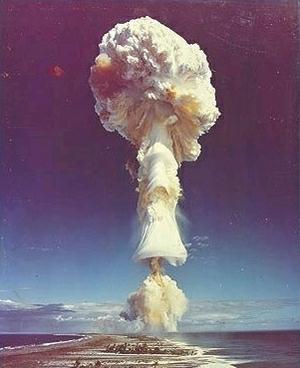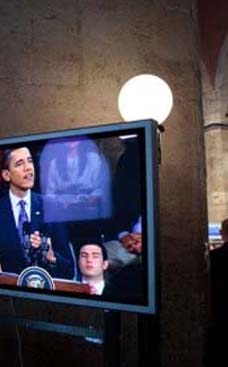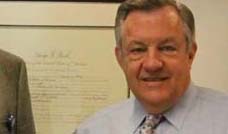
From 1966 to 1990, 167 nuclear test explosions have been performed on Moruroa and Fangataufa, two atolls in the southeastern area of the Tuamotu Archipelago, French Polynesia. These tests were used for the development of at least eight types of nuclear warheads. Of the 167 tests, 44 were atmospheric, 39 over Moruroa, 5 over Fangataufa. The overall yield of these atmospheric explosions was 12,000 kilotons of TNT. The first atmospheric test was performed on Moruroa on July 2, 1966, the last on September 15, 1974. Most of the early tests were performed on the surface or on a barge anchored in the lagoon. Because of the large amount of radioactive fallout resulting from the low burst altitude, most further tests were performed with warheads hanging under balloons. Very few tests were conducted as air-drops from planes. One test, designed to check the security apparatus of the warhead, resulted in no nuclear detonation, but the fragmented bomb spread huge amounts of plutonium over the coral rim. The first explosion of a two stage fissionfusion device on August 24, 1988 at Fangataufa was also the largest explosion, with a yield of 2.6 megatons.
Environmental Effects of French Nuclear Testing in the Pacific
Environmental Effects of French Nuclear Testing
The following report has been distributed by the International Physicians for the Prevention of Nuclear War and the Institute for Energy and Environmental Research, as a result of renwewed interest in French nuclear testing in the South Pacific. It is an updated version of Chapter 9 from the book "Radioactive Heaven and Earth: the health and environmental effects of nuclear weapons testing, in, on, and above the earth."(New York, Apex Press, 1991) It is one of the few published sources for information on this subject, and reveals that although only limited environmental impact reports have been conducted in French Polynesia,and despite restrictions imposed by the French, they still highlight the threat to the environment in the Pacific posed by the French nuclear testing programme.
Location of Tests in the Pacific
The French test sites in the Pacific are Moruroa and Fangataufa, two atolls in the southeastern area of the Tuamotu Archipelago, French Polynesia. The Moruroa Atoll (21.83o Southern latitude and 138.88o Western longitude) is one of the largest coral atolls in that area. The atoll, in the form of an incomplete ring encircling a lagoon, measures 26 km. east to west and 10 km north to south. The 65km.-long reefcrown, with a mean height of 2 meters and rarely exceeding 400 meters in width, is open, leaving a 5-km-wide passage into the lagoon on the northwestern side. The lagoon has an average depth of 40 meters and is the crater of an extinct underwater volcano, around which outer coral has grown above sea level to form the visible rim. The distance to the nearest inhabited island (Tureia) is 100 kilometers, the distance to Tahiti is 1,200 kilometers, and New Zealand is 4,200 kilometers away. The atoll was uninhabited before the installation of the test center.(1)
Fangataufa, a much smaller atoll, is located 41 kilometers south- southeast of Moruroa (22.25o Southern latitude and 138.63o Western longitude). It measures 5 by 8 kilometers and was also uninhabited before the tests. In contrast to Moruroa, Fangataufa was a closed atoll. The French military therefore opened a 400 meter gap in the coral ring to enable ships to enter the lagoon.(2)
From 1966 to 1990, 167 nuclear test explosions have been performed on these two atolls. These tests were used for the development of at least eight types of nuclear warheads. Of the 167 tests, 44 were atmospheric, 39 over Moruroa, 5 over Fangataufa. The overall yield of these atmospheric explosions was 12,000 kilotons of TNT. The first atmospheric test was performed on Moruroa on July 2, 1966, the last on September 15, 1974. Most of the early tests were performed on the surface or on a barge anchored in the lagoon. Because of the large amount of radioactive fallout resulting from the low burst altitude, most further tests were performed with warheads hanging under balloons. Very few tests were conducted as air-drops from planes. One test, designed to check the security apparatus of the warhead, resulted in no nuclear detonation, but the fragmented bomb spread huge amounts of plutonium over the coral rim. The first explosion of a two stage fissionfusion device on August 24, 1988 at Fangataufa was also the largest explosion, with a yield of 2.6 megatons.
After June 5, 1975 the tests were conducted underground. Since then between 4 and 11 underground explosions have been conducted each year. Of the total, 3 were in Fangataufa in 1975 and 1988, the other 120 at Moruroa. The yields of these explosions have never been officially released but the total yield is estimated at about 2,500 kilotons TNT. This estimate is based largely upon observations by the New Zealand Department of Scientific & Industrial Research (DSIR) and the Swedish National Defense Research Institute (FOA), which recorded and analyzed the seismic data from these tests.(3)
The underground tests have been conducted at the bottom of shafts bored 500-1200 meters into the basalt core of the atoll. Initially these shafts were drilled in the outer rim of the atoll. In 1981, most likely due to the weakening of that rim, the tests with higher yields were shifted to shafts drilled under the lagoon itself. In 1986 all tests were shifted to this so called 'zone-central'.(4)
Downwind Communities
Moruroa was selected for atmospheric testing because only 5,000 inhabitants lived within a 1,000 kilometer radius of the testing site. Yet, the initial dangerzone around the test site, which was to be kept free of planes and ships during a test, contained seven inhabited atolls. When this was pointed out to the French authorities, they reduced the radius of the zone designated as dangerous, but the atoll of Tureia, with around 60 inhabitants, 100 kilometers away from Moruroa, remained in the danger area. This island seems to have received severe radioactive fallout several times. One occasion was the test series of JuneJuly 1967, when two French meteorologists on Tureia were evacuated two days after a test and transferred to the hospital at Hao. A complete evacuation of Tureia took place in 1968.(14) Despite these evacuations, the French authorities described the radiation doses on Tureia and Gambier from these tests as never exceeding 75 millirems per year.(15)
The French Atomic Energy Commission acknowledged many years later that the 1966 Aldebarran tests covered the islands of Mureia, Tamoure, and Gambier with radioactive fallout resulting in radiation doses of 200 to 400 millirems.(16) Because the immediate downwind communities are very small and under the control of the French government and independent radiation data are not available, the impact of the atmospheric tests on nearby communities cannot be judged. French military control over the health system of Polynesia is an obstacle to data collection. Health statistics from the period of atmospheric testing were either not collected, poorly collected, or not published. Missions of longer duration, a lifting of the "military secret" classification on health and environmental aspects of testing, and careful epidemiological surveys would be needed to assess the radiological impact of testing on the health of the population across the region.
The most intense monitoring program of the Pacific region was performed by the National Radiation Laboratory of the New Zealand Department of Health, in co operation with the Meteorological Service, the Australian Radiation Laboratory, and the governments of various Pacific islands. These measurements show that, although fission products from the tests were expected to circle the globe in an eastward direction, reaching the southern Pacific again after three weeks, rapid changes in radioactivity concentration in the days immediately after a test were occasionally observed in various Southern Pacific monitoring stations, indicating that radioactive material had been caught up and swept west to the central South Pacific.
The whole South Pacific should be considered a downwind community. Total beta activity in the air was elevated for all monitoring stations in New Zealand as well as on Pacific islands including Fiji, Samoa, Tonga and Tahiti for the whole period from 1966 to 1975. The same is true for total beta activity in rain. Measurements of gamma emitters in air at Tahiti returned to pre test levels in 1975, after being elevated for the five previous years. Approximate mean effective dose equivalent commitments from nuclear test fallout in New Zealand, Fiji and Tahiti normalized finally between 1975 and 1980.(17) All these data suggest a strong linkage between the concentration of fission products and French atmospheric tests from 1966 until 1974.
In a broader sense, downwind communities also include the South American countries. Most tests were performed with winds blowing to the east to avoid direct contamination of the Pacific islands west of Moruroa. Radiation levels up to 12 millirems were attributed to the French test as far away as Peru and Baja California.(18)
Hot Spots in Samoa and Tahiti
At least two hot spots in the South Pacific have been identified by radiation measurements. Both are linked to rainouts. One occurred in Samoa, 3,610 kilometers from Moruroa, on September 12, 1966. This was a consequence of the test Betelgeuse on the previous day, in which a 120 kiloton bomb hanging under a balloon was exploded at a height of 600 meters, despite worsening wind conditions. (President de Gaulle attended this test, and it has been suggested that this was why the bomb was detonated in spite of unfavorable winds.)(22) As a result of that rain-out, the total beta activity in rain in Apia/Samoa in the year 1966 increased from a normal level of around 200 megabecquerels per square kilometer to 370,000 megabecquerels per square kilometer.
Another incident of similar magnitude occurred at Tahiti on July 19, 1974, following a test on July 17 or 18 of unknown yield and burst height. As a consequence, the average annual concentration of total beta activity in the air, which is normally below 0.3 millibecquerels per cubic meter, increased to 1,460 millibecquerels per cubic meter in Papeete Tahiti. The effective dose equivalent from nuclear test fallout due to external shortlived gamma exposure increased from below 1 millisieverts to 154 millisieverts.(23) It is not known whether there have been additional incidents because detailed information for other locations in French Polynesia is not available.
\readsubEnvironmental Effects of Atmospheric Testing}
The total amount of plutonium-239 dispersed as a result of the 45 announced French atmospheric tests, including the four in Algeria, would be about 6750 curies, assuming 150 curies per test. Table 2, in Chapter 3, gives an estimate for the fission yield of the announced French atmospheric tests of about 10.9 megatons. On this basis, the amount of cesium-127 and strontium90 dispersed would have been 1.7 million curies and 1.1 million curies respectively. About onehalf of the cesium and strontium still remains in the atmosphere, on the ground, and in water bodies. French testing in the Pacific was the source of almost all the atmospheric fission product contamination, due to the much larger number of tests and the far greater yields of the French tests there than in Algeria.
References
1) Atkinson, H.R., et al., "Report of a New Zealand, Australian, and Papua New Guinea Scientific Mission to Moruroa Atoll, October-November 1983," Wellington: New Zealand Ministry of Foreign Affairs (1984); Cousteau Foundation Scientific Mission of the Calypso at the Moruroa Nuclear Test Site, (official translation by External Assessments Bureau, Ministry of External Relations and Trade, Wellington), Paris (November 1988); Burrows, A.S., Norris, R.S., Arkin, W.M., Cochran, T.B., "French Nuclear Testing 1960 1988," Natural Resources Defense Council, Washington (1989).
2) Atkinson, et al. 1984, Cousteau Foundation 1988, Burrows et al. 1989. 3) Swedish National Defense Research Institute. 1987. Computer printout of nuclear explosions. Hagsfors Observatory; Smith, W., "Underground Nuclear Explosions in the Tuamotu Archipelago," Geophysics Dept., DSIR, Wellington, 1989.
4) Burrows et al, 1989 and May, John. 1989. "The Greenpeace Book of the Nuclear Age." Pantheon Books.
5) Direction Des Centres d'Experimentations Nucleaires. 1985. Dossier No. 1: Organization et Fonctionnement des Centers d'Experimentations, Nucleaires, Paris.
6) Greenpeace New Zealand. 1985. "French Polynesia: The Nuclear Tests - a Chronology," Auckland, New Zealand; Hughes, S., European Parliament Session, Document A2 0283/88, (1 December 1988); Burrows et al. 1989.
7) Danielsson, B. 1984. "Under the Cloud of Secrecy: The French Nuclear Tests in the South-Eastern Pacific," Ambio, 13 (5-6).
8) Burrows et al. 1989.
9) Tazieff, H. 1982. Rapport d'Haroun Tazieff sur l'ensemble de la Mission Scientifique en Polynesie Francaise, Paris.
10) Atkinson et al. 1984.
11) Cousteau Foundation 1988.
12) Association Des Medicins Francais pour la Prevention de la Guerre Nucleaire. 1990. Les essais nucleaires francais en Polynesie: mission d'etudes et de recontres, 9 16 avril 1990. Medicine at Guerre Nucleaire, vol. 5, no. 3.
13) May 1989, p. 132.
14) Hughes 1988.
15) French Atomic Energy Commission. 1988. Memorandum of the Directorate for Nuclear Test Centers, August 25, 1988. Villecoublay, France.
16) French Atomic Energy Commission.1988.
17) Atkinson et al. 1984.
18) French Atomic Energy Commission 1988.
19) Danielsson 1984.
20) Burrows et al. 1989 and Direction Des Centres d'Experimentations Nucleaires. 1985.
21) Confederation Francaise Democratique du Travail. 1981. Contamination de Moruroa. Statement by CFDT, Section BIII, Paris.
22) Burrows et al. 1989.
23) Atkinson et al. 1984.
24) Atkinson et al. 1984.
25) Direction Des Centres d'Experimentations Nucleaires. 1985.
26) Cousteau Foundation 1988.
27) Tazieff 1982, Atkinson et al. 1984, and Cousteau Foundation 1988.
28) Direction Des Centres d'Experimentations Nucleaires. 1985.
29) Atkinson et al. 1984.
30) Cousteau Foundation 1988.
31) Hochstein, M.P. and M.J. O'Sullivan. 1985. Geothermal Systems created by Underground Nuclear Testing, Proceedings 7th New Zealand Geothermal Workshop. 32) Cousteau Foundation 1988, and Cousteau, J. 1990. Assessment of artificial radionuclides issued from French nuclear bomb testing at Moruroa (French Polynesia), Environmental Technology, vol. 11.
33) Leland, B. 1990. "Greenpeace finds trace radioactivity near Moruroa." PeaceNet, Dec. 10.
34) Buske, N. 1990. Cesium 134 at Moruroa - Review of the Calypso Water Samples, SEARCH Technical Services, Davenport.
35) Marsily, G., E. Lepoux, A. Barbreau, J. Margat. 1977. "Nuclear Waste Disposal: Can the Geologist Guarantee Isolation?" Science.
36) Confederation Francaise Democratique du Travail. 1981.
37) Atkinson et al. 1984.
38) Cousteau Foundation 1989
39) Bagnis, R., et al. 1985. Epidemiology of Ciguatera in French Polynesia from 1960 to 1984, in Gabrie, C. and Salvat, B., eds., Proceedings of the Fifth International Coral Reef Congress, Tahiti, Vol. 4, Moorea: Antenne Museumephe.
40) Ruff, T.A. 1989. Ciguatera in the Pacific: a link with military activities. "Lancet," vol. 1, no. 8631, pp. 201-205.
41) Inoue, A. 1983. Distribution of a Toxic Dinoflagellate, Gambierdiscus toxicus, in French Polynesia, Memoirs of the Kagoshima University Research Centre for the South Pacific, vol.4, no. 1, pp. 918.
42) Helfrich, P. 1960. A Study of the Possible Relationship Between Radioactivity and Toxicity in Fishes from the Central Pacific. U.S. Atomic Energy Commission, Technical Information Service Publication No. TID-5748, Oak Ridge, Tenn.











